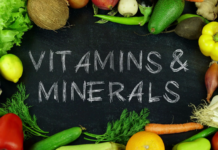REFERENCES
- Piro A, Tagarelli G, Lagonia P, Tagarelli A, Quattrone A. Casimir Funk: his discovery of the vitamins and their deficiency disorders. Ann Nutr Metab 2010;57(2):85-8. doi: 10.1159/000319165
- Hughes RE. James Lind and the cure of scurvy: an experimental approach. Med Hist 1975;19(4):342-51.
- Ruel-Bergeron JC, Stevens GA, Sugimoto JD, Roos FF, Ezzati M, Black RE, Kraemer K. Global Update and Trends of Hidden Hunger, 1995-2011: The Hidden Hunger Index. PLoS One 2015;10(12):e0143497. doi: 10.1371/journal.pone.0143497
- Cavalli-Sforza LT. Public Health & Nutrition in the Asia-Pacific: reflections on a quarter century. Asia Pac J Clin Nutr 2015;24(1):1-9. doi: 10.6133/apjcn.2015.24.1.23
- Food and Agriculture Organization of the United Nations. Addressing social and economic burden of malnutrition through nutrition-sensitive agricultural and food policies in the region of Europe and Central Asia. 2015.
- Lazarus JH. Role of the Iodine Global Network in Elimination of Iodine Deficiency. Recent Pat Endocr Metab Immune Drug Discov 2017. doi: 10.2174/1872214811666170330152202
- Krajcovicova-Kudlackova M, Valachovicova M, Blazicek P. Seasonal folate serum concentrations at different nutrition. Cent Eur J Public Health 2013;21(1):36-8.
- Depa J, Hilzendegen C, Tinnemann P, Stroebele-Benschop N. An explorative cross-sectional study examining self-reported health and nutritional status of disadvantaged people using food banks in Germany. Int J Equity Health 2015;14:141. doi: 10.1186/s12939-015-0276-6
- Bertin M, Touvier M, Dubuisson C, Dufour A, Havard S, Lafay L, Volatier JL, Lioret S. Dietary patterns of French adults: associations with demographic, socio-economic and behavioural factors. J Hum Nutr Diet 2016;29(2):241-54. doi: 10.1111/jhn.12315
- Castetbon K, Mejean C, Deschamps V, Bellin-Lestienne C, Oleko A, Darmon N, Hercberg S. Dietary behaviour and nutritional status in underprivileged people using food aid (ABENA study, 2004-2005). J Hum Nutr Diet 2011;24(6):560-71. doi: 10.1111/j.1365-277X.2011.01158.x
- Galicia L, Grajeda R, de Romana DL. Nutrition situation in Latin America and the Caribbean: current scenario, past trends, and data gaps. Rev Panam Salud Publica 2016;40(2):104-13.
- Lopez de Romana D, Olivares M, Brito A. Introduction: Prevalence of Micronutrient Deficiencies in Latin America and the Caribbean. Food Nutr Bull 2015;36(2 Suppl):S95-7. doi: 10.1177/0379572115585736
- Cediel G, Olivares M, Brito A, Lopez de Romana D, Cori H, La Frano MR. Interpretation of Serum Retinol Data From Latin America and the Caribbean. Food Nutr Bull 2015;36(2 Suppl):S98-108. doi: 10.1177/0379572115585743
- Brito A, Mujica-Coopman MF, Lopez de Romana D, Cori H, Allen LH. Folate and Vitamin B12 Status in Latin America and the Caribbean: An Update. Food Nutr Bull 2015;36(2 Suppl):S109-18. doi: 10.1177/0379572115585772
- Rosenthal J, Casas J, Taren D, Alverson CJ, Flores A, Frias J. Neural tube defects in Latin America and the impact of fortification: a literature review. Public Health Nutr 2014;17(3):537-50. doi: 10.1017/S1368980013000256
- Hwalla N, Al Dhaheri AS, Radwan H, Alfawaz HA, Fouda MA, Al-Daghri NM, Zaghloul S, Blumberg JB. The Prevalence of Micronutrient Deficiencies and Inadequacies in the Middle East and Approaches to Interventions. Nutrients 2017;9(3). doi: 10.3390/nu9030229
- Haddad L, Achadi E, Bendech MA, Ahuja A, Bhatia K, Bhutta Z, Blossner M, Borghi E, Colecraft E, de Onis M, et al. The Global Nutrition Report 2014: actions and accountability to accelerate the world’s progress on nutrition. J Nutr 2015;145(4):663-71. doi: 10.3945/jn.114.206078
- Steyn NP, Wolmarans P, Nel JH, Bourne LT. National fortification of staple foods can make a significant contribution to micronutrient intake of South African adults. Public Health Nutr 2008;11(3):307-13. doi: 10.1017/S136898000700033X
- Papathakis PC, Pearson KE. Food fortification improves the intake of all fortified nutrients, but fails to meet the estimated dietary requirements for vitamins A and B6, riboflavin and zinc, in lactating South African women. Public Health Nutr 2012;15(10):1810-7. doi: 10.1017/S1368980012003072
- Fiedler JL, Macdonald B. A strategic approach to the unfinished fortification agenda: feasibility, costs, and cost-effectiveness analysis of fortification programs in 48 countries. Food Nutr Bull 2009;30(4):283-316. doi: 10.1177/156482650903000401
- Centers for Disease Control and Prevention. Second National Report on Biochemical Indicators of Diet and Nutrition in the U.S. Population. Atlanta, GA: National Center for Environmental Health, 2012.
- Jenab M, Salvini S, van Gils CH, Brustad M, Shakya-Shrestha S, Buijsse B, Verhagen H, Touvier M, Biessy C, Wallstrom P, et al. Dietary intakes of retinol, beta-carotene, vitamin D and vitamin E in the European Prospective Investigation into Cancer and Nutrition cohort. Eur J Clin Nutr 2009;63 Suppl 4:S150-78. doi: 10.1038/ejcn.2009.79
- Olsen A, Halkjaer J, van Gils CH, Buijsse B, Verhagen H, Jenab M, Boutron-Ruault MC, Ericson U, Ocke MC, Peeters PH, et al. Dietary intake of the water-soluble vitamins B1, B2, B6, B12 and C in 10 countries in the European Prospective Investigation into Cancer and Nutrition. Eur J Clin Nutr 2009;63 Suppl 4:S122-49. doi: 10.1038/ejcn.2009.78
For More Information
- Food: Ingredients and Colors, a brochure produced by the International Food Information Council and the FDA, provides a basic overview of food and color additive use, including an overview of the FDA’s additive approval process.
- The FDA also maintains a document called Everything Added to Food in the United States, which lists all of the additives that have been approved for use.
- The Center for Science in the Public Interest has a useful page on additives, including a guide to each additive’s relative safety.
Sources
- Schlosser, Eric, Fast Food Nation: The Dark Side of the All-American Meal (New York: Perennial, 2002: 121).
- U.S. Food and Drug Administration, EAFUS: A Food Additive Database, June 2006.
- U.S. Food and Drug Administration/Center for Food Safety and Applied Nutrition, “The List of “Indirect” Additives Used in Food Contact Substances.” (accessed September 13, 2006).
- Burgess, Wilella Daniels, and April C. Mason, “What Are All Those Chemicals in My Food?”, September 1992 (accessed September 13, 2006).
- Foulke, Judith E, “A Fresh Look at Food Preservatives.” FDA Consumer October 1993 (accessed 3 August, 2006).
- Dalton, Louisa, “Food Preservatives: Antimicrobials, Antioxidants, and Metal Chelators Keep Food Fresh.” Chemical & Engineering News, 80 (November 2002), p. 40.
- Ashurst, Philip R. Food Flavorings (3rd Edition). Gaithersburg (MD): Aspen Publishers, Inc., 1999.
- Schlosser, Eric, Fast Food Nation: The Dark Side of the All-American Meal (New York: Perennial, 2002: 122).
- McDonald’s USA, Ingredients Listing for Popular Menu Items, 20 September 2006, (accessed September 25, 2006).
- U.S. Congress, Code of Federal Regulations 21 C.F.R. 101, chapter 22, paragraph (a)(1). 1 April, 2002.
- Schlosser, Eric, Fast Food Nation: The Dark Side of the All-American Meal (New York: Perennial, 2002: 126-7).
- Ibid, 124
- U.S. Food and Drug Administration/International Food Information Council, “Food Ingredients and Colors,” November 2004.
- Papazian, Ruth. “Sulfites: Safe for Most, Dangerous for Some,” FDA Consumer December 1996 (accessed July 28, 2006).
- Ibid.
- Ibid.
- U.S. Food and Drug Administration. “FDA and Monosodium Glutamate (MSG),” 31 August, 1995 (accessed July 28, 2006).
- Daniells, Stephen. “Nitrites in cured meat linked to lung disease,” Food Production Daily, September 12, 2006.
- U.S. Food and Drug Administration, “Cyclamate Update,” May 16, 1989 (accessed January 20, 2009). See also: U.S. Food and Drug Administration, EAFUS: A Food Additive Database, June 2006.
- Ibid.
- Raloff, Janet. “Carcinogens in the Diet.” Science News Online, 19 February, 2005.
- McCann, Donna, “Food additives and hyperactive behaviour in 3-year-old and 8/9-year-old children in the community: a randomised, double-blinded, placebo-controlled trial.” The Lancet, Volume 370 Issue 9598 (November 3, 2008)
- Hollingham, Richard, “Common Food Additive Doubles Kids’ Hyperactivity”, Discover, January 15, 2008.
- U.S. Department of Agriculture Food Safety and Inspection Service, Fact Sheets: Safe Food Handling–Meat Packaging Materials, May 2002 (accessed August 17, 2006). See also: Burros, Marian. “Which Cut Is Older? (It’s a Trick Question).” New York Times 21 February, 2006.
- Burros, Marian, “Which Cut Is Older? (It’s a Trick Question).”New York Times, February 21, 2006.
- Burros, Marian. “‘Enhanced Meat’ Means Your Steak Gets Watery Injection.” Chicago Tribune 16 August 2006.
- U.S. Food & Drug Administration, “FDA Announces Final Rule Amending the Food Additive Regulations to Allow for the Irradiation of Fresh Iceberg Lettuce and Fresh Spinach,” August 21, 2008
- MacGregor, Hilary E. “Latest food additive: Viruses.” Los Angeles Times, August 28, 2006.
- Schlosser, Eric, Fast Food Nation: The Dark Side of the All-American Meal. (New York: Perennial, 2002: 128).
- U.S. Congress, Federal Food, Drug, and Cosmetic Act., 21 U.S.C. 301, chapter 2, paragraphs (s). (Includes all amendments through December 31, 2004.)
- Dalton, Louisa, “Food Preservatives: Antimicrobials, Antioxidants, and Metal Chelators Keep Food Fresh.” Chemical & Engineering News, 80 (November 2002), p.
References:
(1) http://www.sunfood.com/buy/1/100/Hemp-Seeds-8-oz-Nutiva-raw-shelled-certified-organic-non-GMO.aspx Retrieved October 21st, 2009.
(5) http://hempbasics.com/shop/cms-display/hemp-seed-nutrition.html Retrieved October 21st, 2009
(6) http://nutiva.com/products/nut_charts/0_chart.php Retrieved October 21st, 2009.
(7) Ibid.
(8) http://www.worldpantry.com/cgi-bin/ncommerce3/ProductDisplay?prmenbr=655972&prrfnbr=708933 Retrieved October 21st, 2009.
(9) http://nutiva.com/products/nut_charts/0_chart.php Retrieved October 21st, 2009.
(10) Ibid.
(11) http://www.worldpantry.com/cgi-bin/ncommerce3/ProductDisplay?prmenbr=655972&prrfnbr=708933 Retrieved October 21st, 2009.
(12) Ibid.
(13) http://nutiva.com/products/nut_charts/0_chart.php Retrieved October 21st, 2009.
(14) http://www.umm.edu/altmed/articles/omega-6-000317.htm Retrieved October 21st, 2009.
(15) Ibid.
(16) http://www.cancer-healing.com/toxemia.php Retrieved October 21st, 2009.
The Douglass Report: Dr. William Campbell Douglass, called medicine’s most popular mythbuster.
http://www.medicalnewstoday.com/articles/34040.php, National Institute of Environmental Health Sciences (NIEHS), part of the U.S. Department of Health and Human Services. http://www.dorway.com/rense.html
- Chiu CJ, Liu S, Willett WC, Wolever TM, Brand-Miller JC, Barclay AW, Taylor A., Informing Food Choices and Health Outcomes by Use of The Dietary Glycemic Index., Nutr Rev., 2011 ;69(4): 231-42
02 Temelkova-Kurktschiev TS, Koehler C, Henkel E, Leonhardt W, Fuecker K, Hanefeld M., Postchallenge plasma glucose and glycemic spikes are more strongly associated with atherosclerosis than fasting glucose or HbA1c level., Diabetes Care. 2000 Dec;23(12):1830-4.
- Uchiki T, Weikel KA, Jiao W, Shang F, Caceres A, Pawlak D, Handa JT, Brownlee M, Nagaraj R, Taylor A., Glycation-altered proteolysis as a pathobiologic mechanism that links dietary glycemic index, aging, and age-related disease (in nondiabetics)., Aging Cell. 2012 Feb;11(1):1-13. Doi:10.1111/j 1474-9726.2011.00752.x. Epub 2011 Nov 15.
* Organic Lifestyle Magazine
- White bread breakfast unhealthy?] The Times of India, 10 Mar 2008.
References
- Camilleri M, Colemont LJ, Phillips SF, etc. Human gastric emptying and colonic filling of solids characterized by a new method. Am J Physiol Gastrointest Liver Physiol. 257:284, 1989.
- Charles F, Camilleri M, Phillips SF, etc. Scintigraphy of the whole gut: clinical evaluation of transit disorders. Mayo Clinic Proc 70:113, 1995.
- Degen LP and Phillips SF. Variability of gastrointestinal transit in healthy women and men. Gut 39:299, 1996.
- Iwanaga Y, Wen J, Thollander MS, etc. Scintigraphic measurement of regional gastrointestinal transit in the dog. Am J Physiol Gastrointest Liver Physiol 275:904, 1998.
Metcalf AM, Phillips SF, Zinsmeister AR, etc. Simplified assessment of segmental colonic transit.
- Gastroenterology 92:40, 1987.
Proano M, Camilleri M, Phillips SF, etc. Transit of solids through the human colon: regional quantification in the unprepared bowel. Am J Physiol Gastrointest Liver Physiol 258:856, 1990.
- Surgery Today 1992, Volume 22, Issue 4, pp 386-389
Natural Resources Defense Council Website – www.nrdc.org Everything Added to Food in the United States (EAFUS) November 2011
REFERENCES
REFERENCES
- Barceló A, Aedo C, Rajpathak S, Robles S. The cost of diabetes in Latin America and the Caribbean. Bull World Health Organ. 2003;81:19–27. http://www.ncbi.nlm.nih.gov/pmc/articles/PMC2572319/pdf/12640472.pdf[PMC free article] [PubMed] [Google Scholar]
- International Diabetes Federation. Diabetes Atlas. SeventhE5Seventh Edition, 2015. ISBN: 978–2–930229–81–22. International Diabetes Federation, 2013. Available: www.idf.org/diabetesatlas. Accessed: 11 October 2015.
- The World Health Organization. Assessing National Capacity for the Prevention and Control of Non–communicable Diseases, 2013. Report of the Americas Region, Washington D.C. December 2013.
- Gobierno de Chile. Ministerio de Salud. Universidad Alberto Hurtado. Encuesta Nacional de Salud ENS 2009–2010. V Resultados. Santiago de Chile 2012. http://web.minsal.cl/portal/url/item/bcb03d7bc28b64dfe040010165012d23.pdfAccessed: 21 July 2015.
- Gagliardino JJ, Kleinebreil L, Colagiuri S, Flack J, Caporale JE, Siri F, et al. Comparison of clinical–metabolic monitoring and outcomes and coronary risk status in people with Type 2 diabetes from Australia, France and Latin America. Diabetes Res Clin Pract. 2010;88:7–13. doi: 10.1016/j.diabres.2009.12.024.[PubMed] [CrossRef] [Google Scholar]
- Lopez Stewart G, Tambascia M, Rosas Guzmán J, Etchegoyen F, Ortega Carrión J, Artemenko S. Control of Type 2 diabetes mellitus among general practitioners in nine countries of Latin America. Rev Panam Salud Publica. 2007;22:12–20. doi: 10.1590/S1020-49892007000600002. [PubMed] [CrossRef] [Google Scholar]
- Pan American Health Organization. The Central America Diabetes Initiative (CAMDI): Survey of Diabetes, Hypertension and Chronic Disease Risk Factors. Belize, San José, San Salvador, Guatemala City, Managua and Tegucigalpa. Washington, D.C.: PAHO, © 2011. ISBN: 978–92–75–13098–8. Available: http://www.paho.org/hq/index.php?gid=16710&option=com_docman&task=doc_view. Accessed: 21 July 2015.
- Commendatore V, Dieuzeide G, Faingold C, Fuente G, Lujan D, Aschner P, et al. Registry of people with diabetes in three Latin American countries: a suitable approach to evaluate the quality of health care provided to people with Type 2 diabetes. Int J Clin Pract. 2013;67:1261–6. doi: 10.1111/ijcp.12208.[PubMed] [CrossRef] [Google Scholar]
- Mudaliar U, Kim WC, Kirk K, Rouse C, Narayan KM, Ali M. Are recommended standards for diabetes care met in Central and South America? A systematic review. Diabetes Res Clin Pract. 2013;100:306–29. doi: 10.1016/j.diabres.2013.01.010. [PubMed] [CrossRef] [Google Scholar]
- Rice DP. Estimating the cost of illness. Health Economics Series No. 6, PHS No. 947–6. US Government Printing Office, Washington (DC); 1966. [Google Scholar]
- United Nations World Population Prospects (2009).
- The World Bank. World Development Indicators. Available: http://data.worldbank.org/data–catalog/world–development–indicators. Accessed: 6 April 2015.
- The World Bank. New Country Classification. Available: http://data.worldbank.org/news/new–country–classifications. Accessed: 17 March 2015.
- Pan American Health Organization. Basic Indicator Database. Washington DC 20014.
- Pan American Health Organization. National Capacity for the Management of Chronic Diseases in Latin America & the Caribbean. Washington DC, 2010. [Google Scholar]
- Pan American Health Organization. The Use of Health Resources and Diabetes Complications. The ViCen Survey, 2014.
- Bahia LR, Araujo DV, Schaan BD, Dib SA, Negrato CA, Leăo MP, et al. The costs of Type 2 diabetes mellitus outpatient care in the Brazilian public health system. Value Health. 2011;14(5) Suppl 1:S137–40. doi: 10.1016/j.jval.2011.05.009. [PubMed] [CrossRef] [Google Scholar]
- Escobar MC. Ministerio de Salud de Chile. Evaluación de la calidad de la atención de pacientes diabéticos controlados en establecimientos del Sistema Nacional de Servicios de Salud Resultados: Plan de Reforzamiento QUALIDIAB–Chile 2011. Santiago de Chile, 2012. Available: http://www.redcronicas.cl/wrdprss_minsal/wp–content/uploads/2014/04/Plan–de–Reforzamiento–QUALIDIAB–Chile–2011–Dra–Escobar1.pdf. Accessed: 11 October 2015.
- Arredondo A, Aviles R. Costos y consecuencias financieras del cambio en el perfil epidemiológico en enfermedades crónicas en México. Technical Report. 1999–2014. Update of costs and probabilistic models, June 2014.
- Hennis A, Wu SY, Nemesure B, Li X, Leske MC, Barbados Eye Study Group Diabetes in a Caribbean population: epidemiological profile and implications. Int J Epidemiol. 2002;31:234–9. doi: 10.1093/ije/31.1.234. [PubMed] [CrossRef] [Google Scholar]
- Phillips M, Salmerón J. Diabetes in Mexico – a serious and growing problem. World Health Stat Q. 1992;45:338–46. [PubMed] [Google Scholar]
- Ministerio de Salud. Cuba. III Encuesta Nacional de Factores de Riesgo de y Actividades Preventivas de Enfermedades No Transmisibles. Editorial Ciencias Médicas. ISBN 978–959–212–894–1. Habana, Cuba, 2014. [Google Scholar]
- Gomes de Moura AA, Freese de Carvalho E, Carvalho da Silva NJ. Impacts of non–transmissible chronic diseases on social security benefits. Cięncia & Saúde Coletiva 2007;12(6):1661–1672. Available: http://www.scielo.br/pdf/csc/v12n6/v12n6a25.pdf.Accesse: 23 April 2017. [PubMed]
- Governo do Brasil G. Ministerio de Previdęncia Social. Anuario Estadístico da Previdencia Social 2015. Available: http://www.previdencia.gov.br/wp–content/uploads/2015/08/AEPS–2015–FINAL.pdf. Accessed: 23 May 2017.
- Kirigia MJ, Sambo HB, Sambo LG, Barry SP. Economic burden of diabetes mellitus in the WHO African Region. BMC Int Health Hum Rights. 2009;9 doi: 10.1186/1472-698X-9-6. [PMC free article][PubMed] [CrossRef] [Google Scholar]
- American Diabetes Association Economic Cost of Diabetes in the US in 2012. Diabetes Care. 2013;36:1033–46. doi: 10.2337/dc12-2625. [PMC free article] [PubMed] [CrossRef] [Google Scholar]
- Elgart JF, Asteazaran S, De La Fuente JL, Camillucci C, Brown JB, Gagliardino JJ. Direct and indirect costs associated to Type 2 diabetes and its complications measured in a social security institution of Argentina. Int J Public Health. 2014;59:851–7. doi: 10.1007/s00038-014-0604-4. [PubMed] [CrossRef] [Google Scholar]
- da Rocha Fernandes J, Ogurtsova K, Linnenkamp U, Guariguata L, Seuring T, Zhang P, et al. IDF Diabetes Atlas estimates of 2014 global health expenditure on diabetes. Diabetes Res Clin Pract. 2016;117:48–54. doi: 10.1016/j.diabres.2016.04.016. [PubMed] [CrossRef] [Google Scholar]
- Arredondo A. Type 2 diabetes and health care costs in Latin America: exploring the need for greater preventive medicine. BMC Med. 2014;12:136. doi: 10.1186/s12916-014-0136-z. [PMC free article][PubMed] [CrossRef] [Google Scholar]
- Pan American Health Organization. The Pan American Health Organization Strategy Fund. Available: http://www.paho.org/hq/index.php?option=com_content&view=article&id=12163%3Apaho–strategic–fund&catid=8775%3Aabout&Itemid=42005&lang=en. Accessed: 26 May 2017.
- Mayer-Davis EJ, Lawrence JM, Dabelea D, et al. Incidence trends of type 1 and type 2 diabetes among youths, 2002–2012. N Engl J Med. 2017;376:1419–1429.
- Murphy D, McCulloch CE, Lin F, et al. Trends in prevalence of chronic kidney disease in the United States. Ann Intern Med. 2016;165:473–481.
- Centers for Disease Control and Prevention. Chronic Kidney Disease (CKD) Surveillance Project website.
https://nccd.cdc.gov/CKD/default.aspx. Accessed June 16, 2017. - United States Renal Data System. 2016 USRDS Annual Data Report: Epidemiology of Kidney Disease in the United States. Bethesda, MD: National Institute of Diabetes and Digestive and Kidney Diseases, National Institutes of Health; 2016.
- Centers for Disease Control and Prevention. About Underlying Cause of Death 1999–2015. CDC WONDER Database. http://wonder.cdc.gov/ucd-icd10.html. Updated December 2016. Accessed April 4, 2017.
- American Diabetes Association. Economic costs of diabetes in the U.S. in 2012. Diabetes Care. 2013;36(4):1033–1046.
Suggested Citation
Centers for Disease Control and Prevention. National Diabetes Statistics Report, 2017. Atlanta, GA: Centers for Disease Control and Prevention, U.S. Dept of Health and Human Services; 2017
REFERENCES
- Goldman LS, Genel M, Bezman RJ, Slanetz PJ. Diagnosis and treatment of attention-deficit/hyperactivity disorder in children and adolescents. Council on Scientific Affairs, American Medical Association. JAMA. 1998;279(14):1100–107. [PubMed] [Google Scholar]
- Polanczyk G, de Lima MS, Horta BL, Biederman J, Rohde LA. The worldwide prevalence of ADHD: a systematic review and metaregression analysis. Am J Psychiatry. 2007;164(6):942–8. [PubMed] [Google Scholar]
- Wilens TE, Faraone SV, Biederman J. Attention-deficit/hyperactivity disorder in adults. JAMA. 2004;292(5):619–23. [PubMed] [Google Scholar]
- Swanson JM, Sergeant JA, Taylor E, Sonuga-Barke EJ, Jensen PS, Cantwell DP. Attention-deficit hyperactivity disorder and hyperkinetic disorder. Lancet. 1998;351(9100):429–33. [PubMed] [Google Scholar]
- Biederman J, Faraone SV. Attention-deficit hyperactivity disorder. Lancet. 2005;366(9481):237–48.[PubMed] [Google Scholar]
- American Psychiatric Association Diagnostic and Statistical Manual of Mental Disorders, 4th ed.Washington, DC: American Psychiatric Press; 1994 [Google Scholar]
- Biederman J. Attention-deficit/hyperactivity disorder: a selective overview. Biol Psychiatry. 2005;57(11):1215–20. [PubMed] [Google Scholar]
- Williams NM, Zaharieva I, Martin A, Langley K, Mantripragada K, Fossdal R, et al. Rare chromosomal deletions and duplications in attention-deficit hyperactivity disorder: a genome-wide analysis. Lancet. 2010;376(9750):1401–8. [PMC free article] [PubMed] [Google Scholar]
- Castellanos FX, Tannock R. Neuroscience of attention-deficit/hyperactivity disorder: the search for endophenotypes. Nat Rev Neurosci. 2002;3(8):617–28. [PubMed] [Google Scholar]
- Castellanos FX, Lee PP, Sharp W, Jeffries NO, Greenstein DK, Clasen LS, et al. Developmental trajectories of brain volume abnormalities in children and adolescents with attention-deficit/hyperactivity disorder. JAMA. 2002;288(14):1740–8. [PubMed] [Google Scholar]
- Gornick MC, Addington A, Shaw P, Bobb AJ, Sharp W, Greenstein D, et al. Association of the dopamine receptor D4 (DRD4) gene 7-repeat allele with children with attention-deficit/hyperactivity disorder (ADHD): an update. Am J Med Genet B Neuropsychiatr Genet. 2007;144B(3):379–82. [PubMed] [Google Scholar]
- Pliszka SR, Crismon ML, Hughes CW, Corners CK, Emslie GJ, Jensen PS, et al. The Texas Children’s Medication Algorithm Project: revision of the algorithm for pharmacotherapy of attention-deficit/hyperactivity disorder. J Am Acad Child Adolesc Psychiatry. 2006;45(6):642–57. [PubMed] [Google Scholar]
- Pliszka S; AACAP Work Group on Quality Issues Practice parameter for the assessment and treatment of children and adolescents with attention-deficit/hyperactivity disorder J Am Acad Child Adolesc Psychiatry 200746(7)894–921. [PubMed] [Google Scholar]
- Faraone SV, Glatt SJ. A comparison of the efficacy of medications for adult attention-deficit/hyperactivity disorder using meta-analysis of effect sizes. J Clin Psychiatry. 2010;71(6):754–63.[PubMed] [Google Scholar]
- Faraone SV, Buitelaar J. Comparing the efficacy of stimulants for ADHD in children and adolescents using meta-analysis. Eur Child Adolesc Psychiatry. 2010;19(4):353–64. [PubMed] [Google Scholar]
- Polanczyk G, Rohde LA, Szobot C, Schmitz M, Montiel-Nava C, Bauermeister JJ. ADHD treatment in Latin America and the Caribbean. J Am Acad Child Adolesc Psychiatry. 2008;47(6):721–2. [PubMed]
- M. de Fatima Marinho de Souza, V.P. Gawryszewski, P. Orduñez, A. Sanhueza, M.A.EspinalCardiovascular disease mortality in the Americas: current trends and disparities
Heart, 98 (2012), pp. 1207-1212
Organización Panamericana de la Salud/Organización Mundial de la Salud (OPS/OMS), Información y Análisis de Salud (HSD/HA): Situación de Salud en las Américas: Indicadores Básicos 2012, Estados Unidos de América, Washington, D.C (2012)
- C. Albala, F. Vio, J. Kain, R. UauyNutrition transition in Latin America: the case of Chile
Nutr Rev, 59 (2001), pp. 170-176
View Record in ScopusGoogle Scholar
- S. Yusuf, S. Hawken, S. Ounpuu, et al., INTERHEART Study InvestigatorsEffect of potentially modifiable risk factors associated with myocardial infarction in 52 countries (the INTERHEART study): case-control study
Lancet, 364 (2004), pp. 937-952
ArticleDownload PDFView Record in ScopusGoogle Scholar
- F. Lanas, A. Avezum, L.E. Bautista, et al., INTERHEART Investigators in Latin AmericaRisk factors for acute myocardial infarction in Latin America: the INTERHEART Latin American study
Circulation, 115 (2007), pp. 1067-1074
CrossRefView Record in ScopusGoogle Scholar
- Ciruzzi, H. Schargrodsky, P. Pramparo, et al.Attributable risks for acute myocardial infarction in four countries of Latin America
Medicina (B Aires), 63 (2003), pp. 697-703
View Record in ScopusGoogle Scholar
L.S. Piegas, A. Avezum, J.C. Pereira, et al., AFIRMAR Study InvestigatorsRisk factors for myocardial infarction in Brazil
Am Heart J, 146 (2003), pp. 331-338
ArticleDownload PDFView Record in ScopusGoogle Scholar
World Health OrganizationObesity: Preventing and Managing the Global Epidemic. WHO Technical Report Series 894
World Health Organization, Geneva, Switzerland (2000)
R.H. Eckel, D.A. York, S. Rössner, et al., American Heart AssociationPrevention Conference VII: obesity a worldwide epidemic related to heart disease and stroke: executive summary
Circulation, 110 (2004), pp. 2968-2975
CrossRefView Record in ScopusGoogle Scholar
- Berrington de Gonzalez, P. Hartge, J.R. Cerhan, et al.Body-mass index and mortality among 1.46 million white adults
N Engl J Med, 363 (2010), pp. 2211-2219
D.A. York, S. Rössner, I. Caterson, et al., American Heart AssociationPrevention Conference VII: obesity, a worldwide epidemic related to heart disease and stroke: group I: worldwide demographics of obesity
Circulation, 110 (2004), pp. e463-e470
- Logue, H.M. Murray, P. Welsh, et al.Obesity is associated with fatal coronary heart disease independently of traditional risk factors and deprivation
Heart, 97 (2011), pp. 564-568
CrossRefView Record in ScopusGoogle Scholar
C.D. Lee, D.R. Jacobs Jr., P.J. Schreiner, C. Iribarren, A. HankinsonAbdominal obesity and coronary artery calcification in young adults: the Coronary Artery Risk Development in Young Adults (CARDIA) study
Am J Clin Nutr, 86 (2007), pp. 48-54
View Record in ScopusGoogle Scholar
B.M. Kaess, J. Jozwiak, M. Mastej, et al.Association between anthropometric obesity measures and coronary artery disease: a cross-sectional survey of 16,657 subjects from 444 Polish cities
Heart, 96 (2010), pp. 131-135
CrossRefView Record in ScopusGoogle Scholar
- Gruson, M. Montaye, F. Kee, et al.Anthropometric assessment of abdominal obesity and coronary heart disease risk in men: the PRIME study
Heart, 96 (2010), pp. 136-140
CrossRefView Record in ScopusGoogle Scholar
- Coutinho, K. Goel, D. Corrêa de Sá, et al.Central obesity and survival in subjects with coronary artery disease: a systematic review of the literature and collaborative analysis with individual subject data
J Am Coll Cardiol, 57 (2011), pp. 1877-1886
ArticleDownload PDFView Record in ScopusGoogle Scholar
- Coutinho, K. Goel, D. Corrêa de Sá, et al.Combining body mass index with measures of central obesity in the assessment of mortality in subjects with coronary disease: role of “normal weight central obesity”
J Am Coll Cardiol, 61 (2013), pp. 553-560
ArticleDownload PDFView Record in ScopusGoogle Scholar
V.L. Roger, A.S. Go, D.M. Lloyd-Jones, et al., American Heart Association Statistics Committee and Stroke Statistics SubcommitteeHeart disease and stroke statistics—2012 update: a report from the American Heart Association
Circulation, 125 (2012), pp. e2-220
View Record in ScopusGoogle Scholar
- Uauy, C. Albala, J. KainObesity trends in Latin America: transiting form under-to overweight
J Nutr, 131 (2001), pp. 893S-899S
J.J. Miranda, V.M. Herrera, J.A. Chirinos, et al., Latin American Consortium of Studies in ObesityMajor cardiovascular risk factors in Latin America: a comparison with the United States
PLoS One, 8 (2013), p. e54056
M.I. Schmidt, B.B. Duncan, G. Azevedo e Silva, et al.Chronic non-communicable diseases in Brazil: burden and current challenges
Lancet, 377 (2011), pp. 1949-1961
ArticleDownload PDFView Record in ScopusGoogle Scholar
Encuesta Nacional de Salud y Nutrición 2012. Available at: http://ensanut.insp.mx/informes/ENSANUT2012ResultadosNacionales.pdf. Accessed June 2, 2013.
Encuesta Nacional de Salud ENS 2007. Available at: http://www.scp.com.co/ArchivosSCP/boletines_Pedianet/DocumentosPedianet/Encuesta_Nacional_de_Salud_2007.pdf. Accessed June 2, 2013.
Encuesta Nacional de Factores de Riesgo. Argentina 2005. Available at: http://msal.gov.ar/ENT/VIG/Publicaciones/Encuestas_Poblacionales/PDF/Encuesta%20Nacional%20De%20Factores%20De%20Riesgo%202005%20-%20Version%20Breve.pdf. Accessed June 2, 2013.
Encuesta Nacional de Salud ENS Chile 2009 to 2010. Available at: http://www.minsal.cl/portal/url/item/bcb03d7bc28b64dfe040010165012d23.pdf. Accessed June 2, 2013.
- Poirier, T.D. Giles, G.A. Bray, et al.Obesity and cardiovascular disease: pathophysiology, evaluation, and effect of weight loss: an update of the 1997 American Heart Association Scientific Statement on Obesity and Heart Disease from the Obesity Committee of the Council on Nutrition, Physical Activity, and Metabolism
Circulation, 113 (2006), pp. 898-918
CrossRefView Record in ScopusGoogle Scholar
R.J. Shepard, G.J. BaladyExercise as cardiovascular therapy
Circulation, 99 (1999), pp. 963-972
- Boraita PérezEjercicio, piedra angular de la prevención cardiovascular [Exercise as the cornerstone of cardiovascular prevention]
Rev Esp Cardiol, 61 (2008), pp. 514-528
ArticleDownload PDFView Record in ScopusGoogle Scholar
Encuesta Nacional de Factores de Riesgo de Enfermedades Crónicas. No Transmisibles. Available at: http://www.deres.org.uy/home/descargas/campanas/encuesta-nacional-factores-riesgo.pdf. Accessed June 2, 2013.
- Pérez Carrillo, M. Cortes Mogollon, F. Henriquez Villalba, et al.Prevalencia de diabetes mellitus y otros factores de riesgo cardiovascular en la región central de Venezuela: pesquisa realizada en el área metropolitana de Caracas, Valencia y Maracay abril-mayo 1997
Arch Hosp Vargas, 39 (1997), pp. 123-128
I.M. Lee, E.J. Shiroma, F. Lobelo, et al., Lancet Physical Activity Series Working GroupEffect of physical inactivity on major non-communicable diseases worldwide: an analysis of burden of disease and life expectancy
Lancet, 380 (2012), pp. 219-229
ArticleDownload PDFView Record in ScopusGoogle Scholar
B.E. Saelens, J.F. Sallis, J.B. Black, D. ChenNeighborhood-based differences in physical activity: an environment scale evaluation
Am J Public Health, 93 (2003), pp. 1552-1558
CrossRefView Record in ScopusGoogle Scholar
- PopkinUrbanization, lifestyle changes and the nutrition transition
World Dev, 27 (1999), pp. 1905-1916
ArticleDownload PDFView Record in ScopusGoogle Scholar
W.L. Haskell, I.M. Lee, R.R. Pate, et al.Physical activity and public health: updated recommendation for adults from the American College of Sports Medicine and the American Heart Association
Circulation, 116 (2007), pp. 1081-1093
View Record in ScopusGoogle Scholar
- Hillsdon, C. Foster, M. ThorogoodInterventions for promoting physical activity
Cochrane Database Syst Rev, 1 (2005), p. CD003180
View Record in ScopusGoogle Scholar
- Goldstein, E. Jacoby, R. del Aguila, A. LopezPoverty is a predictor of non-communicable disease among adults in Peruvian cities
Prev Med, 41 (2005), pp. 800-806
ArticleDownload PDFView Record in ScopusGoogle Scholar
V.L. Roger, A.S. Go, D.M. Lloyd-Jones, et al., American Heart Association Statistics Committee and Stroke Statistics SubcommitteeExecutive summary: heart disease and stroke statistics—2012 update: a report from the American Heart Association
Circulation, 125 (2012), pp. 188-197
View Record in ScopusGoogle Scholar
Encuesta Nacional de Salud 2011 to 2012. Available at: http://www.msc.es/estadEstudios/estadisticas/encuestaNacional/encuestaNac2011/PresentacionENSE2012.pdf. Accessed June 2, 2013.
- Silva, R. Hernandez-Hernandez, R. Vinueza, et al., CARMELA Study InvestigatorsCardiovascular risk awareness, treatment, and control in urban Latin America
Am J Ther, 17 (2010), pp. 159-166
CrossRefView Record in ScopusGoogle Scholar
W.H. Herman, P. ZimmetType 2 diabetes: an epidemic requiring global attention and urgent action
Diabetes Care, 35 (2012), pp. 943-944
CrossRefView Record in ScopusGoogle Scholar
B.V. Howard, B.L. Rodriguez, P.H. Bennett, et al.Prevention Conference VI: diabetes and cardiovascular disease: writing group I: epidemiology
Circulation, 105 (2002), pp. e132-e137
View Record in ScopusGoogle Scholar
- Yang, J. Lu, J. Weng, et al., China National Diabetes and Metabolic Disorders Study GroupPrevalence of diabetes among men and women in China
N Engl J Med, 362 (2010), pp. 1090-1101
CrossRefView Record in ScopusGoogle Scholar
D.J. KimThe epidemiology of diabetes in Korea
Diabetes Metab J, 35 (2011), pp. 303-308
CrossRefView Record in ScopusGoogle Scholar
- Leong, K. Dasgupta, J.L. Chiasson, E. RahmeEstimating the population prevalence of diagnosed and undiagnosed diabetes
Diabetes Care, 36 (2013), pp. 3002-3008
CrossRefView Record in ScopusGoogle Scholar
T.C. Lee, R.J. Glynn, J.M. Peña, et al.Socioeconomic status and incident type 2 diabetes mellitus: data from the Women’s Health Study
PLoS One, 6 (2011), p. e27670
Centers for Disease Control and PreventionIncreasing prevalence of diagnosed diabetes—United States and Puerto Rico, 1995-2010
MMWR Morb Mortal Wkly Rep, 61 (2012), pp. 918-921
M.L. Daviglus, G.A. Talavera, M.L. Avilés-Santa, et al.Prevalence of major cardiovascular risk factors and cardiovascular diseases among Hispanic/Latino individuals of diverse backgrounds in the United States
JAMA, 308 (2012), pp. 1775-1784
CrossRefView Record in ScopusGoogle Scholar
Ministerio de Salud. Instituto Nacional de Salud (INS). Centro Nacional de Alimentación y Nutrición (CENAN). Encuesta Nacional de Indicadores Nutricionales, Bioquímicos, Socioeconómicos y Culturales relacionados con las enfermedades crónicas degenerativas. Lima: INS-CENAN; 2006.
W.B. Kannel, D.L. McGeeDiabetes and cardiovascular risk factors: the Framingham study
Circulation, 59 (1979), pp. 8-13
CrossRefView Record in ScopusGoogle Scholar
N.J. Morrish, S.L. Wang, L.K. Stevens, J.H. Fuller, H. KeenMortality and causes of death in the WHO Multinational Study of Vascular Disease in Diabetes
Diabetologia, 44 (Suppl 2) (2001), pp. S14-S21
CrossRefView Record in ScopusGoogle Scholar
W.L. Lee, A.M. Cheung, D. Cape, B. ZinmanImpact of diabetes on coronary artery disease in women and men: a meta-analysis of prospective studies
Diabetes Care, 23 (2000), pp. 962-968
CrossRefView Record in ScopusGoogle Scholar
- Lindström, P. Ilanne-Parikka, M. Peltonen, et al., Finnish Diabetes Prevention Study GroupSustained reduction in the incidence of type 2 diabetes by lifestyle intervention: follow-up of the Finnish Diabetes Prevention Study
Lancet, 368 (2006), pp. 1673-1679
ArticleDownload PDFView Record in ScopusGoogle Scholar
- Penn, M. White, J. Oldroyd, M. Walker, K.G. Alberti, J.C. MathersPrevention of type 2 diabetes in adults with impaired glucose tolerance: the European Diabetes Prevention RCT in Newcastle upon Tyne
- BMC Public Health, 9 (2009), p. 342
Diabetes Prevention Program Research GroupThe 10-year cost-effectiveness of lifestyle intervention or metformin for diabetes prevention: an intent-to-treat analysis of the DPP/DPPOS
Diabetes Care, 35 (2012), pp. 723-730
- Saito, M. Watanabe, J. Nishida, et al., Zensharen Study for Prevention of Lifestyle Diseases GroupLifestyle modification and prevention of type 2 diabetes in overweight Japanese with impaired fasting glucose levels: a randomized controlled trial
Arch Intern Med, 171 (2011), pp. 1352-1360
CrossRefView Record in ScopusGoogle Scholar
- Perk, G. De Backer, H. Gohlke, et al.European Guidelines on cardiovascular disease prevention in clinical practice (version 2012): the Fifth Joint Task Force of the European Society of Cardiology and Other Societies on Cardiovascular Disease Prevention in Clinical Practice (constituted by representatives of nine societies and by invited experts)
Eur Heart J, 33 (2012), pp. 1635-1701
View Record in ScopusGoogle Scholar
L.F. Stead, T. LancasterGroup behaviour therapy programmes for smoking cessation
Cochrane Database Syst Rev, 2 (2005), p. CD001007
View Record in ScopusGoogle Scholar
- Lancaster, L.F. SteadIndividual behavioural counselling for smoking cessation
Cochrane Database Syst Rev, 2 (2005), p. CD001292
View Record in ScopusGoogle Scholar
National Institute for Health and Clinical Excellence. NICE Public Health Guidance 10. Smoking Cessation Services in Primary Care, Pharmacies, Local Authorities and Workplaces, Particularly for Manual Working Groups, Pregnant Women and Hard to Reach Communities. 2008. Available at: http://www.nice.org.uk/nicemedia/pdf/PH010guidance.pdf. Accessed June 2, 2013.
OMS. Convenio Marco de la OMS para el Control del Tabaco. Geneva, Switzerland: WHO Document Production Services, 2003. Available at: http://www.who.int/tobacco/framework/WHO_fctc_spanish.pdf. Accessed June 2, 2013.
Fundación Interamericana del Corazón. Convenio Marco para el Control del Tabaco: desafíos para América Latina y el Caribe. Reporte de la Sociedad Civil 2010. Available at: http://www.alatorax.org/images/stories/demo/pdf/Convenios/reporte_cmct_espanol.pdf. Accessed June 2, 2013.
M.M. Finucane, G.A. Stevens, M.J. Cowan, et al., Global Burden of Metabolic Risk Factors of Chronic Diseases Collaborating Group (Body Mass Index)National, regional, and global trends in body-mass index since 1980: systematic analysis of health examination surveys and epidemiological studies with 960 country-years and 9.1 million participants
Lancet, 377 (2011), pp. 557-567
ArticleDownload PDFView Record in ScopusGoogle Scholar
- Mendis, P. Puska, B. Norrving (Eds.), Global Atlas on Cardiovascular Disease Prevention and Control, World Health Organization, Geneva, Switzerland (2011)
G.A. Giovino, S.A. Mirza, J.M. Samet, et al., GATS Collaborative GroupTobacco use in 3 billion individuals from 16 countries: an analysis of nationally representative cross-sectional household surveys
Lancet, 380 (2012), pp. 668-679
ArticleDownload PDFView Record in ScopusGoogle Scholar
- OrdúñezCardiovascular health in the Americas: facts, priorities and the UN high-level meeting on non-communicable diseases
MEDICC Rev, 13 (2011), pp. 6-10
CrossRefView Record in ScopusGoogle Scholar
E.M. Sebrié, E. Sandoya, E. Bianco, et al.Hospital admissions for acute myocardial infarction before and after implementation of a comprehensive smoke-free policy in Uruguay: experience through 2010
Tob Control (2013 May 24)
[E-pub ahead of print]
Portal Brasil. Remédio gratuito: Programa Saúde Não Tem Preço oferece medicamentos gratuitos a pacientes de hipertensão e diabetes. April 15, 2012. Available at: http://www.brasil.gov.br/saude/2012/04/remedio-gratuito Accessed September 30, 2013.
N.C. Nazzal, T.P. Campos, H.R. Corbalán, et al., Grupo GEMI, Departamento de Estudios Multicéntricos, Sociedad Chilena de Cardiología Cardiovascular[The impact of Chilean health reform in the management and mortality of ST elevation myocardial infarction (STEMI) in Chilean hospitals]
Rev Med Chil, 136 (2008), pp. 1231-1239
View Record in ScopusGoogle Scholar
World Health Organization. The World Health Report 2001. Mental health: new understanding, new hope. Geneva: World Health Organization; 2001.
- Kirmayer L. Minas H. The future of cultural psychiatry: an international perspective. Can J Psychiatry. 2000;45:438–446. [PubMed] [Google Scholar]
- De Almeida Filho N. Canino G. Epidemiología psiquiátrica. In: Vidal G, Alarcón RD, Lolas F, editors. Enciclopedia iberoamericana de psiquiatría. Vol. 2. Buenos Aires: Editorial Médica Panamericana; 1995. pp. 487–501. [Google Scholar]
- Murray CJL. Lopez AD. The global burden of disease. Cambridge: Harvard University Press; 1996.[Google Scholar]
- Üstün TB. The global burden of mental disorders. Am J Publ Health. 1999;89:1315–1318.[PMC free article] [PubMed] [Google Scholar]
- Organización Panamericana de la Salud. Salud para todos en el año 2000. Plan de acción para la instrumentación de las estrategias regionales. Washington: Organización Panamericana de la Salud; 1982.
- Levav I. Lima BR. Somoza-Lennon M, et al. Salud mental para todos en América Latina y el Caribe. Bases epidemiològicas para la acciòn. Bol Sanit Panam. 1989;107:196–219. [PubMed] [Google Scholar]
- Vasquez J. Promoción y protección de los derechos humanos básicos de las personas con discapacidades mentales y sus familiares. Presented at the Conference on Mental Health in the Americas: Partnering for Progress; November 2001; Washington. [Google Scholar]
- Alarcón RD. Hispanic psychiatry: from margin to mainstream. Transcult Psychiatry. 2001;38:5–25.[Google Scholar]
- Saraceno B. Saxena S. Mental health resources in the world: results from Project ATLAS of the WHO. World Psychiatry. 2002;1:40–44. [PMC free article] [PubMed] [Google Scholar]
- Gonzalez R. Salud mental en la comunidad en América Latina. Ejemplo de programas. In: Levav I, editor. Temas de salud mental en la comunidad. Washington: Organización Panamericana de la Salud; 1992. pp. 291–312. [Google Scholar]
- Academia Nacional de Medicina de Buenos Aires. Seminario- Taller sobre la formación del psiquiatra y su certificaciòn. Buenos Aires: Prensa Médica Argentina; 2000. [Google Scholar]
- Alarcón RD. Mental health in Latin America, circa 2001-2002. In: Sepûlveda J, editor. Salud panamericana. Mexico: 2002. pp. 114–126. [Google Scholar]
- Vergara C. El contexto de las reformas del sector de la salud. Rev Panam Salud Pûblica. 2000;8:7–12.[PubMed] [Google Scholar]
- Pucheu C. Torres J. de la Fuente JR. Marcos de referencia para la investigacion socio-médica psiquiátrica. Salud Mental. 1985;8:8–15. [Google Scholar]
- Mari JJ. Mental health research in Latin America. Presented at the Conference on Mental Health in the Americas: Partnering for Progress; November 2001; Washington. [Google Scholar]
- Alarcón RD. Perspectivas de la investigación psiquiátrica en América Latina. Acta Psiq Psicol Am Latina. 1993;39:19–31. [PubMed] [Google Scholar]
- Murray CJL. Gakidou EE. Frenk J. Health inequalities and social group differences: what should we measure? WHO Bull. 1999;77:537–543. [PMC free article] [PubMed] [Google Scholar]
(1) http://www.sunfood.com/buy/1/100/Hemp-Seeds-8-oz-Nutiva-raw-shelled-certified-organic-non-GMO.aspx Retrieved October 21st, 2009.
(5) http://hempbasics.com/shop/cms-display/hemp-seed-nutrition.html Retrieved October 21st, 2009
(6) http://nutiva.com/products/nut_charts/0_chart.php Retrieved October 21st, 2009.
(7) Ibid.
(8) http://www.worldpantry.com/cgi-bin/ncommerce3/ProductDisplay?prmenbr=655972&prrfnbr=708933 Retrieved October 21st, 2009.
(9) http://nutiva.com/products/nut_charts/0_chart.php Retrieved October 21st, 2009.
(10) Ibid.
(11) http://www.worldpantry.com/cgi-bin/ncommerce3/ProductDisplay?prmenbr=655972&prrfnbr=708933 Retrieved October 21st, 2009.
(12) Ibid.
(13) http://nutiva.com/products/nut_charts/0_chart.php Retrieved October 21st, 2009.
(14) http://www.umm.edu/altmed/articles/omega-6-000317.htm Retrieved October 21st, 2009.
(15) Ibid.
(16) http://www.cancer-healing.com/toxemia.php Retrieved October 21st, 2009.
References – PubMed
J Affect Disord. 1999 Dec;56(2-3):189-94 –Indian J Clin Biochem. 2005 Jul;20(2):158-61 – J Res Med Sci. 2012 Jul;17(7):607-14 – Eur Psychiatry. 2019 Apr;57:46-51 – Am J Psychiatry. 1960 Sep;117:234-5 – J Biol Chem. 2015 Dec 25;290(52):31151-61 – Br J Psychiatry. 2013 Mar;202(3):195-203 – Am J Med. 1998 May;104(5):413-21 – J Am Board Fam Med. 2010 Sep-Oct;23(5):677-80 – J Affect Disord. 2015 Sep 15;184:90-6 – Mol Neurobiol. 2018 May;55(5):4195-4206 – Biol Trace Elem Res. 2016 Jun;171(2):275-282 – Rinsho Byori. 2014 Feb;62(2):133-8 – Prog Neuropsychopharmacol Biol Psychiatry. 2011 Apr 29;35(3):702-21 – J Neurosci. 2000 Feb 15;20(4):1374-85 – Acta Psychiatr Scand. 2019 May;139(5):404-419 – PLoS One. 2017 Jun 27;12(6):e0180067 Nat Rev Neurosci. 2002 Mar;3(3):175-90 – Scientifica (Cairo). 2017;2017:4179326 – Biol Trace Elem Res. 2010 Feb;133(2):153-61 – Physiol Rev. 2015 Jan;95(1):1-46 – World J Biol Psychiatry. 2019 May 23;:1-12 – Psychoneuroendocrinology. 2018 May;91:198-205 – Hum Psychopharmacol. 2001 Jan;16(1):71-80 – Nutr Neurosci. 2013 Sep;16(5):191-206 – Growth Factors. 2018 Aug;36(3-4):178-185 – CNS Neurol Disord Drug Targets. 2018;17(8):618-625 – J Med Case Rep. 2014 Oct 03;8:326 – BJPsych Open. 2018 Jul;4(4):167-179 – Biol Psychiatry. 1996 Sep 1;40(5):428-9 – Biol Psychiatry. 1988 Feb 15;23(4):367-76 – J Crit Care. 2002 Sep;17(3):203-5 – Prog Neuropsychopharmacol Biol Psychiatry. 2011 Apr 29;35(3):676-92 – Front Immunol. 2013 Oct 11;4:324 – Magnes Res. 2016 Mar 1;29(3):112-119 – Prog Neuropsychopharmacol Biol Psychiatry. 2005 Feb;29(2):201-17 – BMC Psychiatry. 2018 Apr 10;18(1):94 – Nutrients. 2017 Apr 26;9(5): – Mol Cell Biochem. 1992 Mar 25;110(2):169-73 – Clin Chem. 1985 Feb;31(2):244-6 – Br J Psychiatry. 2013 Feb;202:100-7 – Metab Brain Dis. 2017 Feb;32(1):97-103 – Pharmacol Rep. 2013;65(3):547-54 – Aging Cell. 2007 Jun;6(3):267-73 – Am J Clin Pathol. 1976 Oct;66(4):634-8 – Psychiatry Res. 2017 Jun;252:80-86 – Neuropsychobiology. 1999;39(2):63-70 – Am J Clin Pathol. 1977 May;67(5):505 – Nature. 1994 Jun 9;369(6480):486-8 – BMC Med. 2013 Aug 27;11:187 – Neuropsychobiology. 1996;34(1):26-8 – Open Heart. 2018 Jan 13;5(1):e000668 – Mol Psychiatry. 2014 Apr;19(4):444-51 – Aust N Z J Psychiatry. 2009 Jan;43(1):45-52 – Psychol Med. 2006 Jun;36(6):797-805 – J Affect Disord. 2013 Dec;151(3):924-31 – J Immunol. 2012 Jun 15;188(12):6338-46 – World J Biol Psychiatry. 2007;8(1):56-9 – Nutr Neurosci. 2012 Mar;15(2):78-84 – J Affect Disord. 2015 Aug 15;182:106-14 – J Clin Psychiatry. 2019 Jan 15;80(1): – Int J Psychiatry Clin Pract. 2013 Feb;17(1):30-4 – Hum Psychopharmacol. 2000 Dec;15(8):631-635 – Med Princ Pract. 2016;25(3):219-26 – N Engl J Med. 1968 Apr 4;278(14):772-6 concl – Med Hypotheses. 2011 Oct;77(4):508-28 – Intern Med J. 2015 Apr;45(4):436-40 – Clin Chim Acta. 2011 Apr 11;412(9-10):696-701 – J Affect Disord. 1994 Jun;31(2):135-40 – JAMA Psychiatry. 2014 Dec 1;71(12):1381-91 – Mol Neurobiol. 2018 Dec;55(12):8885-8903- BMC Bioinformatics. 2012;13 Suppl 14:S10 – Bruninx R. Retinitis pigmentosa. Review Medicine Liege. 2020;75(2):73–74. – Wang W., Lo A. Diabetic retinopathy: pathophysiology and treatments. International Journal of Molecular Sciences. 2018;19(6):1816–1830. doi: 10.3390/ijms19061816. – DOI – Simó R., Villarroel M., Corraliza L., Hernández C., Garcia-Ramírez M. The Retinal Pigment Epithelium: Something More than a Constituent of the Blood-Retinal Barrier—Implications for the Pathogenesis of Diabetic Retinopathy. Journal of Biomedicine and Biotechnology. 2010;2010:15. doi: 10.1155/2010/190724. – DOI – PMC – Strauss O. The retinal pigment epithelium in visual function. Physiological Reviews. 2005;85(3):845–881. doi: 10.1152/physrev.00021.2004. – DOI – Khandhadia S., Lotery A. Oxidation and age-related macular degeneration: insights from molecular biology. Expert Reviews in Molecular Medicine. 2010;12, article e34 doi: 10.1017/S146239941000164X. – DOI – Beatty S., Koh H.-H., Phil M., Henson D., Boulton M. The role of oxidative stress in the pathogenesis of age-related macular degeneration. Survey of Ophthalmology. 2000;45(2):115–134. doi: 10.1016/S0039-6257(00)00140-5. – DOI – Li K. R., Yang S. Q., Gong Y. Q., et al. 3H–1,2-dithiole-3-thione protects retinal pigment epithelium cells against ultra-violet radiation via activation of Akt-mTORC1-dependent Nrf2-HO-1 signaling. Science Reprots. 2016;6 – PMC – Zhang C., Shu L., Kong A.-N. T. MicroRNAs: new players in cancer prevention targeting Nrf2, Oxidative Stress and Inflammatory Pathways. Current Pharmacology Reports. 2015;1(1):21–30. doi: 10.1007/s40495-014-0013-7. – DOI – PMC – Kwak M. K., Egner P. A., Dolan P. M., Ramos-Gomez M., Groopman J. D., Itoh K. Role of phase 2 enzyme induction in chemoprotection by dithiolethiones. Mutation Research. 2001;305(15):480–481. – Mirończuk-Chodakowska I., Witkowska A. M., Zujko M. E. Endogenous non-enzymatic antioxidants in the human body. Advances in Medical Sciences. 2018;63(1):68–78. doi: 10.1016/j.advms.2017.05.005. – DOI – Itoh K., Mimura J., Yamamoto M. Discovery of the negative regulator of Nrf2, Keap1: a historical overview. Antioxidants & Redox Signaling. 2010;13(11):1665–1678. doi: 10.1089/ars.2010.3222. – DOI – Baird L., Dinkova-Kostova A. T. The cytoprotective role of the Keap1-Nrf2 pathway. Archives of Toxicology. 2011;85(4):241–272. doi: 10.1007/s00204-011-0674-5. – DOI – Mitsuishi Y., Motohashi H., Yamamoto M. The Keap1-Nrf2 system in cancers: stress response and anabolic metabolism. Frontiers in Oncology. 2012;2(16):123–140. – PMC – Kensler T. W., Wakabayashi N., Biswal S. Cell survival responses to environmental Stresses Via the Keap1-Nrf2-ARE pathway. Annual Review of Pharmacology and Toxicology. 2007;47(1):89–116. doi: 10.1146/annurev.pharmtox.46.120604.141046. – DOI – Loboda A., Damulewicz M., Pyza E., Jozkowicz A., Dulak J. Role of Nrf2/HO-1 system in development, oxidative stress response and diseases: an evolutionarily conserved mechanism. Cellular and Molecular Life Sciences. 2016;73(17):3221–3247. doi: 10.1007/s00018-016-2223-0. – DOI – PMC – Zhao Z., Chen Y., Wang J., et al. Age-related retinopathy in NRF2-deficient mice. PLoS ONE. 2011;6(4) – PMC – Ni M., Li X., Yin Z., Jiang H., Sidoryk-Wegrzynowicz M. Methylmercury induces acute oxidative stress, altering Nrf2 protein level in primary microglial cells. Toxicology Sciences. 2010;116:590–603. – PMC – Innamorato N. G., Rojo A. I., Garcia-Yague A. J., Yamamoto M., de Ceballos M. L. The transcription factor Nrf2 is a therapeutic target against brain inflammation. Journal of Immunology. 2008;181:680–689. – Rojo A. I., Innamorato N. G., Martin-Moreno A. M., De Ceballos M. L., Yamamoto M. Nrf2 regulates microglial dynamics and neuroinflammation in experimental Parkinson’s disease. Glia. 2010;58:588–598. – Hollyfield J. G., Bonilha V. L., Rayborn M. E., Yang X., Shadrach K. G. Oxidative damage-induced inflammation initiates age-related macular degeneration. Nature Medicine. 2008;14(2):194–198. doi: 10.1038/nm1709. – DOI – PMC – Chhatre S., Nesari T., Somani G., Kanchan D., Sathaye S. Phytopharmacological overview of Tribulus terrestris. Pharmacognosy Reviews. 2014;8(15):45–51. doi: 10.4103/0973-7847.125530. – DOI – PMC – Samani N. B., Jokar A., Soveid M., Heydari M., Mosavat S. H. Efficacy of the hydroalcoholic extract of Tribulus terrestris on the serum glucose and lipid profile of women with diabetes mellitus: a double-blind randomized placebo-controlled clinical trial. Journal of Evidence-Based Complementary & Alternative Medicine. 2016;21(4):91–97. – Reshma P. L., Binu P., Anupama N., et al. Pretreatment of Tribulus terrestris L. causes anti-ischemic cardioprotection through MAPK mediated anti-apoptotic pathway in rat. Biomedicine & Pharmacotherapy. 2019;111:1342–1352. doi: 10.1016/j.biopha.2019.01.033. – DOI – GamalEl Din S. F., Abdel Salam M. A., Mohamed M. S., et al. Tribulus terrestris versus placebo in the treatment of erectile dysfunction and lower urinary tract symptoms in patients with late-onset hypogonadism: a placebo-controlled study. Urologia. 2018;86(2):74–78. – Zhang H., Tong W.-T., Zhang C.-R., et al. Gross saponin of Tribulus terrestris improves erectile dysfunction in type 2 diabetic rats by repairing the endothelial function of the penile corpus cavernosum. Diabetes, Metabolic Syndrome and Obesity: Targets and Therapy. 2019;Volume 12:1705–1716. doi: 10.2147/DMSO.S205722. – DOI – PMC – Xie X., Feng J., Kang Z., et al. Taxifolin protects RPE cells against oxidative stress-induced apoptosis. Molecular Vision. 2017;23:520–528. – PMC – Weiwei D., An Y., He X., Zhang D., He W. Protection of kaempferol on oxidative stress-induced retinal pigment epithelial cell damage. Oxidative Medicine and Cellular Longevity. 2018;2018:14. doi: 10.1155/2018/1610751. – DOI – PMC – Xu X., Li M., Chen W., Yu H., Yang Y., Hang L. Apigenin attenuates oxidative injury in ARPE-19 cells thorough activation of Nrf2 pathway. Oxidative Medicine and Cellular Longevity. 2016;2016:9. doi: 10.1155/2016/4378461. – DOI – PMC – Dinc E., Ayaz L., Kurt A. H. Protective effect of combined caffeic acid phenethyl ester and bevacizumab against hydrogen peroxide-induced oxidative stress in human RPE cells. Current Eye Research. 2017;42(12):718–725. – Arend N., Wertheimer C., Laubichler P., Wolf A., Kampik A., Kernt M. Idebenone prevents oxidative stress, cell death and senescence of retinal pigment epithelium cells by stabilizing BAX/Bcl-2 ratio. Ophthalmologica. 2015;234(2):73–82. doi: 10.1159/000381726. – DOI – He Y., Leung K. W., Ren Y., Pei J., Ge J. PEDF improves mitochondrial function in RPE cells during oxidative stress. Investigative Ophthalmology & Visual Science. 2014;55(10):6742–6755. doi: 10.1167/iovs.14-14696. – DOI – Cui Y., Li Y., Huang N., et al. Structure based modification of chalcone analogue activates Nrf2 in the human retinal pigment epithelial cell line ARPE-19. Free Radical Biology and Medicine. 2020;20:52–59. – Cui R., Tian L., Lu D., Li H., Cui J. Exendin-4 protects human retinal pigment epithelial cells from H2O2-induced oxidative damage via activation of NRF2 signaling. Ophthalmic Research. 2019;20:1–9. – Shao Y., Yu H., Yang Y., Li M., Hang L., Xu X. A solid dispersion of quercetin shows enhanced Nrf2 activation and protective effects against oxidative injury in a mouse model of dry age-related macular degeneration. Oxidative Medicine and Cellular Longevity. 2019;2019:12. doi: 10.1155/2019/1479571. – DOI – PMC – Wang L., Chen Y., Sternberg P., Cai J. Essential roles of the PI3 kinase/Akt pathway in regulating Nrf2-dependent antioxidant functions in the RPE. Investigative Ophthalmology & Visual Science. 2008;49(4):1671–1678. doi: 10.1167/iovs.07-1099. – DOI – PMC – Xu Y., Wang L., Cao L., Chen L., Liu Q. Involvement of NYD-SP15 in growth and oxidative-stress responses of ARPE-19. Journal of Cellular Biochemistry. 2018;120:1362–1375. – Su P., Zhang J., Wang S., et al. Genistein alleviates lead-induced neurotoxicity in vitro and in vivo: Involvement of multiple signaling pathways. Neurotoxicology. 2016;53:153–164. doi: 10.1016/j.neuro.2015.12.019. – DOI – Seen S., Tong L. Dry eye disease and oxidative stress. Acta Ophthalmologica. 2018;96:412–420. – Calderon G. D., Juarez O. H., Hernandez G. E., Punzo S. M., De la Cruz Z. D. Oxidative stress and diabetic retinopathy: development and treatment. Eye. 2017;31(8):1122–1130. doi: 10.1038/eye.2017.64. – DOI – PMC – Kaarniranta K., Kajdanek J., Morawiec J., Pawlowska E., Blasiak J. PGC-1α protects RPE cells of the aging retina against oxidative stress-induced degeneration through the regulation of senescence and mitochondrial quality control. The Significance for AMD Pathogenesis. International Journal of Molecular Sciences. 2018;19(8):p. 2317. doi: 10.3390/ijms19082317. – DOI – PMC – Fanjul-Moles M. L., López-Riquelme G. O. Relationship between oxidative stress, circadian rhythms, and AMD. Oxidative Medicine and Cellular Longevity. 2016;2016:18. doi: 10.1155/2016/7420637.7420637 – DOI – PMC – Uğurlu N., Aşık M. D., Yülek F., Neselioglu S., Cagil N. Oxidative stress and anti-oxidative defence in patients with age-related macular degeneration. Current Eye Research. 2013;38(4):497–502. doi: 10.3109/02713683.2013.774023. – DOI – Sackett C. S., Schenning S. The age-related eye disease study: the results of the clinical trial. Clinical Trial. 2002;27:5–7. – Zhu W., Du Y., Meng H., Dong Y., Li L. A review of traditional pharmacological uses, phytochemistry, and pharmacological activities of Tribulus terrestris. Chemistry Central Journal. 2017;11(1):p. 60. doi: 10.1186/s13065-017-0289-x. – DOI – PMC – Hemalatha S., Hari R. Comparative antioxidant activities of crude ethanolic and saponin rich butanol extracts of Tribulus terrestris fruits. International Journal of Pharmacy and Biological Sciences. 2014;4:784–793. – Zheng W., Wang F., Yang Z., et al. Rapid characterization of constituents in Tribulus terrestris from different habitats by UHPLC/Q-TOF MS. Journal of The American Society for Mass Spectrometry. 2017;28(11):2302–2318. doi: 10.1007/s13361-017-1761-5. – DOI – Ma Y., Guo Z., Wang X. Tribulus terrestris extracts alleviate muscle damage and promote anaerobic performance of trained male boxers and its mechanisms: roles of androgen, IGF-1, and IGF binding protein-3. The Journal of Sport and Health Science. 2015;12:1–8. – PMC – Neychev V., Mitev V. Pro-sexual and androgen enhancing effects of Tribulus terrestris L.: fact or fiction. Journal of Ethnopharmacology. 2015;179:345–355. – Reshma P. L., Sainu N. S., Mathew A. K., Raghu K. G. Mitochondrial dysfunction in H9c2 cells during ischemia and amelioration with Tribulus terrestris L. Life Sciences. 2016;152:220–230. doi: 10.1016/j.lfs.2016.03.055. – DOI – Kostova I., Dinchev D. Saponins in Tribulus terrestris – chemistry and bioactivity. Phytochemistry Reviews. 2005;4(2-3):111–137. doi: 10.1007/s11101-005-2833-x. – DOI – Noda I. Two-dimensional infrared spectroscopy. Journal of the American Chemical Society. 1989;11:8166–8188. – Noda I., Ozaki Y. Two-dimensional correlation spectroscopy-applications in vibrational and optical spectroscopy. Vol. 1. USA: John Wiley&Sons Ltd; 2004. – Liao M. Y., Huang L. N., Zeng P. Effect of Tribulus terrestris L. on the retinal ganglion cells. International Eye Science. 2009;9:282–283. – Li L. B., Li J., Li H. Protective effects of gross saponins of Tribulus terrestris on experimental intracerebral hemorrhage in rats. Journal Harbin Medical University. 2006;40:99–102. – Wang G. D., Sun S. G. Effects of Tribulus terrestris saponins for injection on treatment of coronary heart disease and angina pectoris. Chinese Journal of Gerontology. 2012;32:1480–1481. – Wang B., Ma L., Liu T. 406 Cases of Angina pectoris in coronary heart disease treated with saponin of Tribulus terrestris. Zhong Xi Yi Jie He Za Zhi. 1990;10:85–87. – Xu X.-R., Yu H.-T., Yang Y., Hang L., Yang X.-W., Ding S.-H. Quercetin phospholipid complex significantly protects against oxidative injury in ARPE-19 cells associated with activation of Nrf2 pathway. European Journal of Pharmacology. 2016;770:1–8. doi: 10.1016/j.ejphar.2015.11.050. – DOI – Wang J., Gong H. M., Zou H. H., Liang L., Wu X. Y. Isorhamnetin prevents H2O2 induced oxidative stress in human retinal pigment epithelial cells. Molecular Medicine Reports. 2018;17(1):648–652. doi: 10.3892/mmr.2017.7916. – DOI – Alhasani R. H., Biswas L., Tohari A. M., et al. Gypenosides protect retinal pigment epithelium cells from oxidative stress. Food and Chemical Toxicology. 2018;112:76–85. doi: 10.1016/j.fct.2017.12.037. – DOI – Zhao H., Wang R. Q., Zhang L. Genipin protects against H2O 2 -induced oxidative damage in retinal pigment epithelial cells by promoting Nrf2 signaling. International Journal of Molecular Medicine. 2019;43(2):936–944. doi: 10.3892/ijmm.2018.4027. – DOI – PMC – Zhao B., Wang Z., Han J., Wei G., Yi B., Li Z. Rhizoma paridis total saponins alleviate H2O2-induced oxidative stress injury by upregulating the Nrf2 pathway. Molecular Medicine Reports. 2020;21(1):220–228. doi: 10.3892/mmr.2019.10827. – DOI – PMC – Wang K., Jiang Y., Wang W., Ma J., Chen M. Escin activates AKT-Nrf2 signaling to protect retinal pigment epithelium cells from oxidative stress. Biochemical and Biophysical Research Communications. 2015;468:1–7. – Li Z., Dong X., Liu H., et al. Astaxanthin protects ARPE-19 cells from oxidative stress via upregulation of Nrf2-regulated phase II enzymes through activation of PI3K/Akt. Molecular Vision. 2013;19:1656–1666. – PMC – Feng Z., Liu Z., Li X., et al. α-Tocopherol is an effective Phase II enzyme inducer: protective effects on acrolein-induced oxidative stress and mitochondrial dysfunction in human retinal pigment epithelial cells. Journal of Nutritional Biochemistry. 2010;21(12):1222–1231. doi: 10.1016/j.jnutbio.2009.10.010. – DOI –
The contents of this website are for educational purposes and are not intended to offer personal medical advice. You should seek the advice of your physician or other qualified health provider with any questions you may have regarding a medical condition. Never disregard professional medical advice or delay in seeking it because of something you have read on this website. These website does not recommend or endorse any products.
Los contenidos de este sitio web son para fines educativos de la experiencia de 50 años de investigaciones por Hector Sectzer y no pretenden ofrecer asesoramiento médico personal. Debe buscar el consejo de su médico u otro proveedor de salud calificado si tiene alguna pregunta sobre una condición médica. Nunca ignore el asesoramiento médico profesional ni se demore en buscarlo por algo que haya leído en este sitio web. SmartnessHealth.com y Salud101.com no recomienda ni promociona ningún producto.












